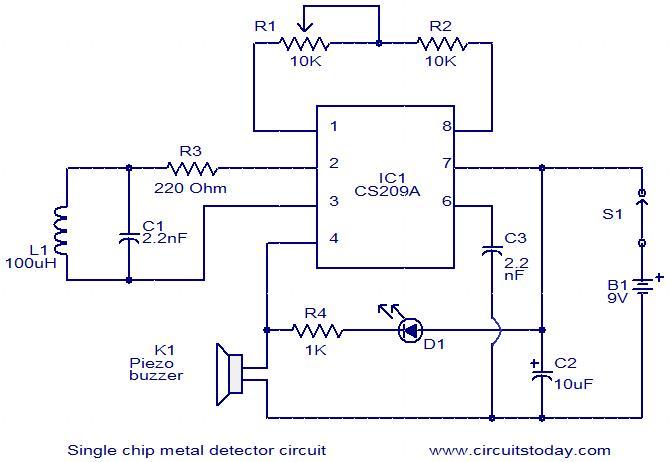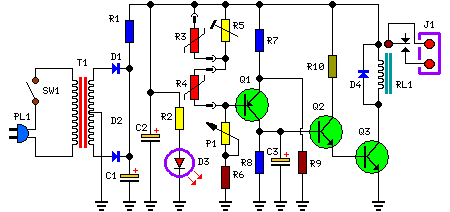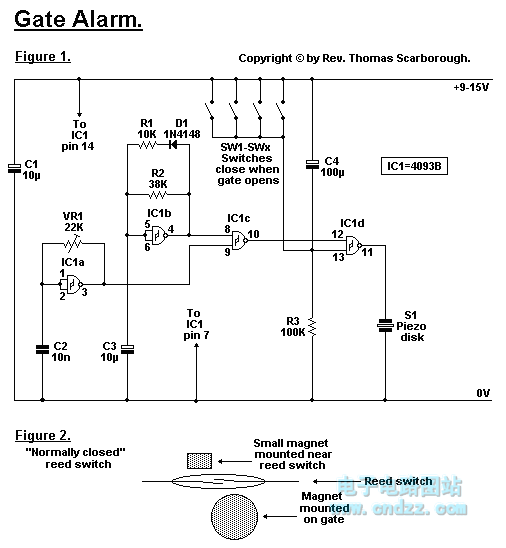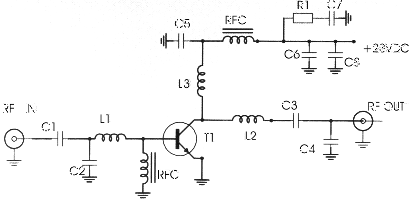
PC based Robot Circuit

To create the circuitry described, a computer software capable of controlling a parallel port is required, with an estimated cost of approximately $30. For instance, a transistor (model number 2N2222) is priced around $0.50, while a DPDT relay costs about $1.75, noting that seven of these relays are needed for the implementation. This design utilizes IC sockets to hold the components, allowing for easy replacement without soldering. Instead of using two 18-pin sockets, a combination of one 10-pin and one 18-pin socket can be utilized.
The described circuit is designed to interface with a computer's parallel port, enabling control over various electronic components. The primary component, the 2N2222 transistor, functions as a switch or amplifier in the circuit, allowing for the control of higher power devices through low-power signals from the parallel port. The DPDT relays serve as the primary switching mechanism, facilitating the control of multiple circuits or devices simultaneously. Given that seven relays are required, they can be organized in a manner that allows for complex control schemes, such as reversing motor direction or switching between different devices.
The use of IC sockets is a notable feature of this design, as it enhances the modularity and maintainability of the circuit. By employing sockets, components can be easily replaced or upgraded without the need for soldering, which is particularly advantageous in prototyping or educational environments. The suggestion to use a combination of 10-pin and 18-pin sockets instead of two 18-pin sockets indicates a flexible approach to design, allowing for the accommodation of various component configurations based on availability or specific project requirements.
Overall, this circuit design emphasizes ease of use and adaptability, making it suitable for a range of applications in electronic control systems. The careful selection of components and the thoughtful layout of the circuit contribute to its functionality and reliability in controlling external devices through a computer interface.In order to create the circuitry below, you need a computer software that will control your parallel port. It will cost you about 30 US$. For example, a transistor (model number 2N2222) costs ~50, a DPDT relay, ~1. 75$ (this is maybe the most expensive piece, you need 7). This implementation uses IC-sockets to hold the pieces. That way, they are not soldered and can be replaced easily. Instead of two 18-pin sockets, you could use 10- and a 18-pin sockets. 🔗 External reference
The described circuit is designed to interface with a computer's parallel port, enabling control over various electronic components. The primary component, the 2N2222 transistor, functions as a switch or amplifier in the circuit, allowing for the control of higher power devices through low-power signals from the parallel port. The DPDT relays serve as the primary switching mechanism, facilitating the control of multiple circuits or devices simultaneously. Given that seven relays are required, they can be organized in a manner that allows for complex control schemes, such as reversing motor direction or switching between different devices.
The use of IC sockets is a notable feature of this design, as it enhances the modularity and maintainability of the circuit. By employing sockets, components can be easily replaced or upgraded without the need for soldering, which is particularly advantageous in prototyping or educational environments. The suggestion to use a combination of 10-pin and 18-pin sockets instead of two 18-pin sockets indicates a flexible approach to design, allowing for the accommodation of various component configurations based on availability or specific project requirements.
Overall, this circuit design emphasizes ease of use and adaptability, making it suitable for a range of applications in electronic control systems. The careful selection of components and the thoughtful layout of the circuit contribute to its functionality and reliability in controlling external devices through a computer interface.In order to create the circuitry below, you need a computer software that will control your parallel port. It will cost you about 30 US$. For example, a transistor (model number 2N2222) costs ~50, a DPDT relay, ~1. 75$ (this is maybe the most expensive piece, you need 7). This implementation uses IC-sockets to hold the pieces. That way, they are not soldered and can be replaced easily. Instead of two 18-pin sockets, you could use 10- and a 18-pin sockets. 🔗 External reference





